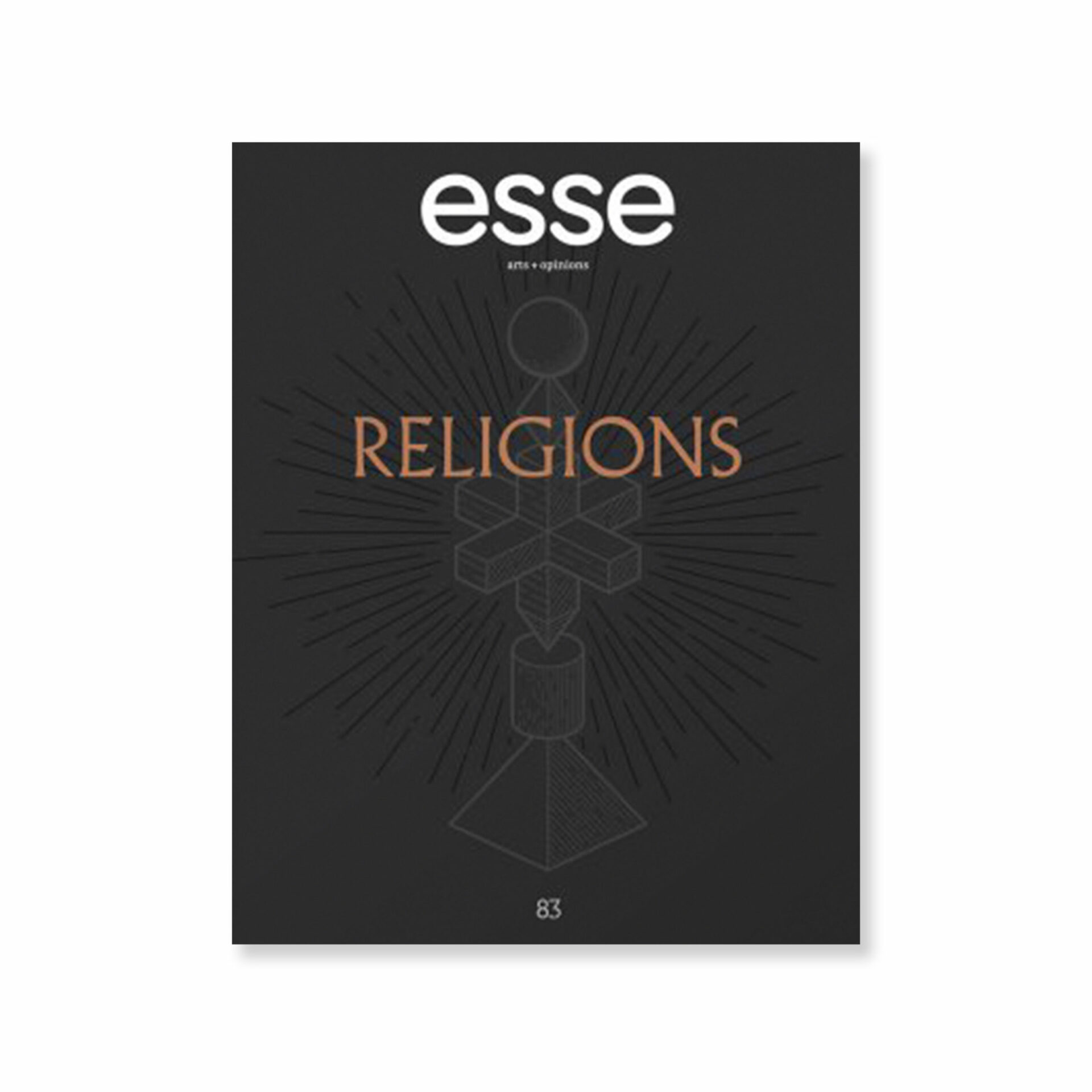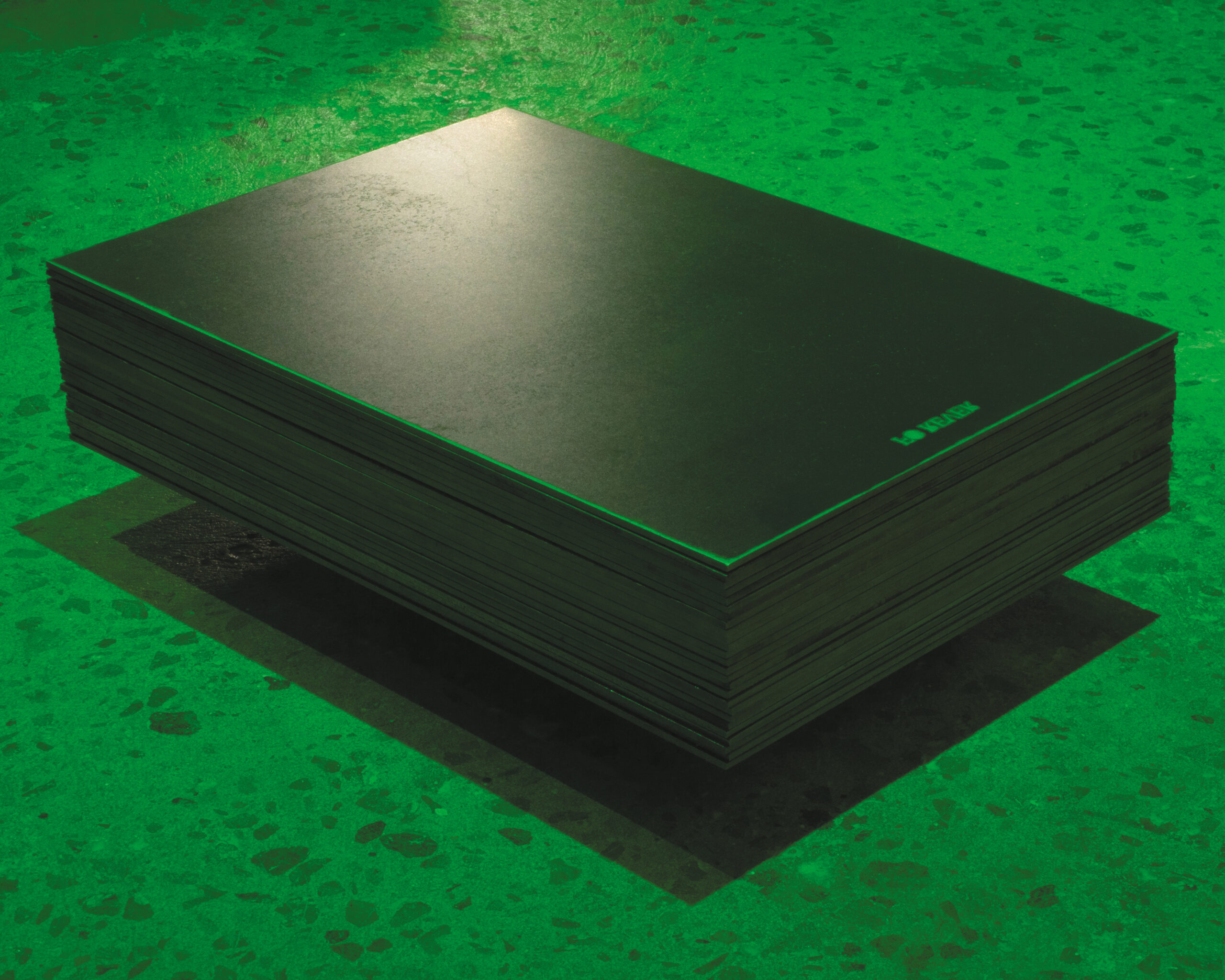
Long before the dialogue around so-called religious practices became widespread, Marcel Mauss stated, “There is, in fact, no such essence or thing called Religion; there are only religious phenomena, more or less integrated into systems called religions, which have a defined historical existence, within groups of humans and at determined times.”1 1 - Marcel Mauss, Œuvres vol. 1 (Paris: Éditions de Minuit, 1968), 93 (our translation). One could postulate that before being an ensemble of moral prescriptions, religion is an assemblage of facts and material phenomena, whose reality often eludes us in a context in which conservative or reactionary positions increasingly focus our attention on ideology and societal differences. Religion is concrete nevertheless, involving repeated gestures, bodily movements, and codified acts.
In the installation Abraham Abraham Sarah Sarah, presented at the Musée d’art et d’histoire du judaïsme in Paris and the Art Gallery of Alberta, Nira Pereg presents a comparative anthropological study of such automatic gestures. The two videos, shown face to face, portray the rituals enacted at one of the world’s most singular religious sites. Associated with both Judaism and Islam, this sacred place changes identity according to the needs and beliefs of the subjects who worship there. A mosque (Haram Ibrahim) for Muslims, and a synagogue and Cave of the Patriarchs for Jews, it is constructed on the burial chambers of Abraham, his wife Sarah, their son Isaac, and their grandson Jacob. Abraham is considered a patriarch or prophet by the three monotheistic religions. Located in Hebron in the West Bank, the site is also a focal point for questions of territory and ownership. During certain religious festivals, the building is reserved solely for one of the religious communities, to the exclusion of the other. After 1994, when twenty-nine Palestinians were massacred by an Israeli settler during Ramadan, the site was reorganized and placed under strict military control, with the introduction of separate entrances and steel doors. The Israeli army is constantly present, requisitioned to safeguard the site and to protect Jews from Muslims, and Muslims from Jews.
It is precisely the moment when the building changes hands — the moment when a new physical and symbolic zone is created — that interested Pereg. The two short videos (lasting less than five minutes each) show groups of men carrying out the same actions. In Sarah Sarah, Muslims can be seen emptying the rooms in preparation for the arrival of Jews: removing the carpets by dragging them to the other end of the space, putting away sacred books, and clearing away cabinets. Some doors are opened, while others are closed… Banners are taken down, and all religious symbols are removed. The movements seem chaotic and fragmented, yet, in reality, they are perfectly orchestrated. Everyone knows what he has to do in order to clear the space, and the army guards put away anything that may have been forgotten. When the space is completely empty, it is ready to be “reterritorialized.” Jews then enter and, in turn, reinstall the objects that they had previously hidden. Certain inscriptions in Arabic, dating back to the building’s construction, are covered up and furniture used in specific rites is moved into place. The building is thus transformed into a synagogue ready to welcome believers. In Abraham Abraham, it is Jews who are taking down sacred objects, moving furniture and cramming it into storage spaces, clearing the rooms before the army again opens the doors to Muslims, allowing them, in turn, to reinstall their prayer mats. The two groups reproduce the same dance, the same ritual ballet that consists of successively emptying and reoccupying the spaces, only to empty them again. The monument seems to stand empty for only a few seconds. But this state of emptiness takes on particular significance here, as it is the only moment when a specific group does not occupy the building, the only moment when the notion of ownership is absent. Emptiness suspends territorial inscriptions.

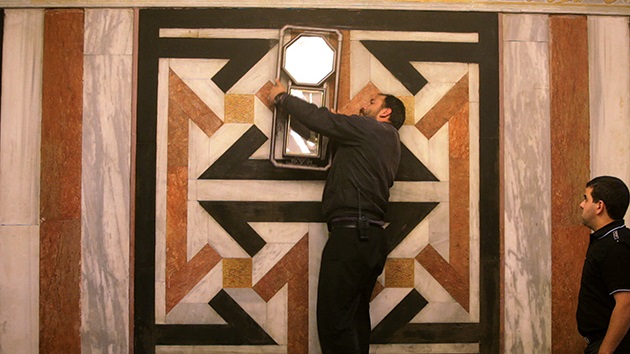
Sarah Sarah, capture vidéo | video still, 2008.
Photo : permission de | courtesy of the artist & Braverman Gallery, Tel Aviv
Pereg accentuates the physical, concrete dimension of the gestures through her use of sound. The sounds of the objects knocking against each other or being pushed, the carpets being dragged, and the doors closing are all amplified. Perceived as hyper-realistic at first, they rapidly become artificial. No human sounds, no voices can be heard. Only sounds related to the ritualistic machinery remain audible. The sound increases the perceived distance between the actors and the actions, obliging the spectator to focus on the material details, on the automatic nature of the gestures, on their rhythmic form. Yet the fact that the two perfectly synchronized sequences are screened simultaneously on facing walls prevents their direct comparison. It’s impossible to watch them both at the same time: when watching one, one misses the other. Pereg thus imposes a rhythm of perception. The editing, sound design, and installation context all contribute to transforming our perception of what is happening in the videos. The gestures mirror each other: Jews and Muslims are carrying out the same actions at the same time. Through the editing, the artist choreographs — in the etymological sense of writing or describing — these repeated rituals to the point of transcribing them with whatever absurdity they may contain.
In this way, Pereg depicts the reality of a machinic unconscious linked to religion, whose mechanisms give rise to the formation of images or words inaccessible to the conscious mind. These, in their own way, construct a refrain (ritornello), an instrumental motif preceding a song, the rituals that precede worship. In Félix Guattari’s view, “Every individual, every group, every nation is ‘equipped’ with a basic range of incantatory refrains.”2 2 - Félix Guattari, The Machinic Unconscious: Essays in Schizoanalysis, trans. Taylor Adkins (Cambridge: MIT Press, 1979), 107.. Guattari and Gilles Deleuze wrote that the refrain is “any aggregate of matters of expression that draws a territory and develops into territorial motifs.”3 3 - Gilles Deleuze and Félix Guattari, A Thousand Plateaus: Capitalism and Schizophrenia, trans. Brian Massumi (Minneapolis: University of Minnesota Press, 1987), 323. 397.. The relationship with the question of territory in Abraham Abraham and Sarah Sarah is obvious. The assemblage is sonorous first, with the musical dimension of the refrain expressed in the editing. The strength of Pereg’s work lies not in a brutal denunciation of the exploitation of religion for political ends, but in its analysis of the “production machine tool of difference,” another definition of refrain. The reality of the repeated gestures and actions, the automatisms performed by these men, demarcate a territory. Pereg clearly shows the movements that constitute or lead to deterritorialization, as well as the objects that may have “valence” for the relinquished territory, as Deleuze specified. In the video Shabbath 2008, another territorial division is presented: the artificial border that ultra-Orthodox Jews set up for the twenty-four-hour period of the Sabbath in and around Jerusalem. The video mainly shows men and children in the process of setting up temporary barriers marked with the word “police” in order to block access to certain areas and close off the space that, during the Sabbath, will become sacred. Here again, the gesture is almost musical; marking territory is not a meter, but a rhythm.4 4 - Ibid, 42. 388..
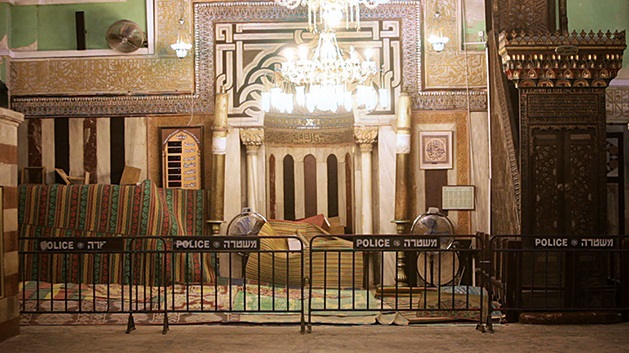
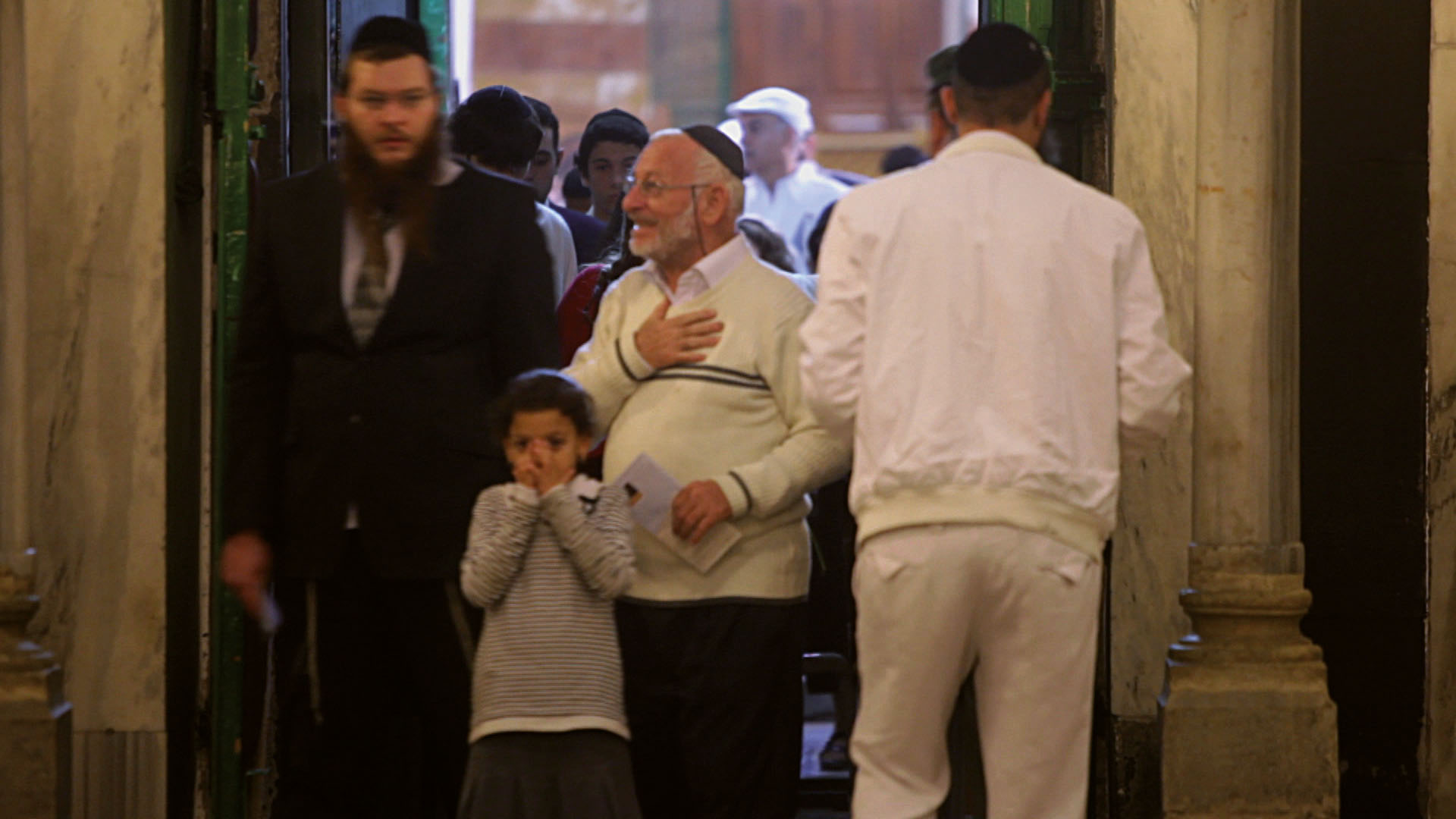
Sarah Sarah, captures vidéos | video stills, 2012.
Photos : permission de | courtesy of the artist & Braverman Gallery, Tel Aviv
Pereg is interested not in the derivative gestures inherent to religious rituals, but in the gestures that surround them or serve as a prelude. The sensitive question of land appropriation in the name of religion is analyzed not by way of religious ideas, but by means of its rituals and material facts, by the programmed gestures of those who seek to control earthly goods for the sake of their beliefs. This sole prerogative over things, beings, and spaces — this form of returning, of perpetual repetition — is here a territory within a territory. Given that freedom of movement is severely restricted in Israel, the constraints, divisions, spatial, and territorial segregations take on such importance due to the different beliefs that make them impossible to forget. Rather than passing moral judgment on these restrictions, Pereg asks how the individual can exist within them. A map does not define a territory. Spaces also have a social dimension that can be understood only by living in them. In Israel, the notion of ownership is very much alive, even when it comes to death. Pereg’s film Kept Alive (2009 – 10) shows Jerusalem’s Har Hamenushot cemetery, one of Israel’s largest and most densely populated burial grounds. Due to the lack of space, burial plots are bought by the living in order to ensure their place in the land of the dead. Stones marked with “Kept Alive” are placed on the empty graves to reserve them for their living owners, giving the markers the sense of an incantation.
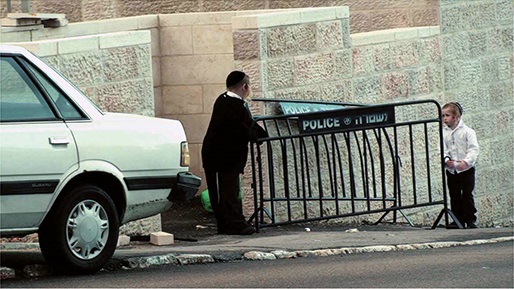
Shabbat 2008, capture vidéo | video still, 2008.
Photo : permission de | courtesy of the artist & Braverman Gallery, Tel Aviv
In a country where land is linked as much with security as with morality or religion, how can space be traversed without considering religious adherence or the gestures and actions that inevitably lead to forms of appropriation? In this sense, Pereg creates a refrain of her own, precisely to liberate herself from the territory at the precise moment when “the expressive is primary in relation to the possessive.”5 5 - Ibid., 316. In Soil (1999), she is portrayed in various locations around Jerusalem, a city with particularly stringent restrictions on freedom of movement. The series of Polaroids show Pereg levitating, her feet hovering above the ground. Would touching the earth systematically imply taking ownership of it? Would this mean responding to the demands of the group? Pereg constantly seems to be seeking an individual response. In the video 67 Bows (2006) she orchestrates the reaction of a group of flamingos in an interior compound of the Karlsruhe zoo in response to repeated stimuli. How does the individual exist in a community? Flamingos were of particular interest to Pereg, as they live in large groups and demonstrate social behaviour. She sought to establish whether, despite this fact, it would be possible to identify individuals, if an individual reaction to a powerful stimulus was possible, and if the group anticipated the stimulus, whenever it happened. The video’s sound design, associating the stimuli with the sounds of gunshots, makes their response all the more explicit.
By isolating gestures and movements, by orchestrating sound and image, Pereg offers a different reading of religious reality. If rituals facilitate religious practice by liberating the mind, their stereotyped, routine dimension also seems inevitably to lead to a loss of self. Often perfunctory in themselves, these rituals engender force by way of repetition. Yet Nira Pereg manages to disrupt them.
[Translated from the French by Louise Ashcroft]
